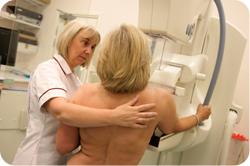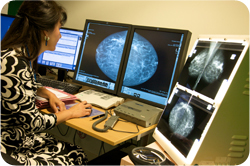Breast Unit
Digital Mammogram
Digital Mammogram
 Radiographer Alison Smith preparing a patient for a mammogram |
On this page: What is it? Are there any risks? Preparing yourself for the test What does it entail? How long does it take? Will it hurt? Digital Breast Tomosynthesis (DBT) When will the results be available? |
What is a mammogram?
A mammogram is the name for an x-ray carried out on the breast. Generally a radiographer carries out this test, but your film will be examined later by a radiologist.
At the RUH the mammograms are produced in digital form and viewed on a computer screen. Digital Mammograms have been proven to be more accurate for women under the age of 50, women with dense glandular breasts, women who are pre or peri-menopausal and women under 50 with a significant family history of breast cancer.
Are there any risks in having a mammogram?
There are some risks involved with x-rays. Most of these relate to the slightly increased risk of developing a cancer. This should, though, be kept in perspective. The amount of radiation involved is equal to that which we receive naturally from the environment over a period of a few months to a year.

Radiographer Alison Smith positioning
a patient for a Mammogram
All risks are relative, and the possible benefits of the examination have to be taken into account as well. If you do have a breast lump, or other significant problem, then the risk of not having the examination will be much greater than the risk associated with the radiation.
If you are pregnant, or think you might be, it is essential that you tell the radiographer. Ultrasound may be used instead. If mammograms are required, then the radiographer will cover your lower stomach with a lead apron. This reduces the radiation dose to your baby even though it is actually a very small dose.
You must also tell the radiographer if you have breast implants.
Are you required to make any special preparations?
Yes, it is important that you do not wear talcum powder. Also make sure that there is no deodorant, antiperspirant or perfume on your breasts.
What does the mammogram entail?

Patient undergoing a Mammogram scan
Once you are in the x-ray room, your breasts will in turn be positioned against part of an x-ray machine. Each breast needs to be compressed between the x-ray machine and a flat digital detector.
A certain amount of heavy pressure is felt briefly. Remember this pressure is important to get good results.
Two x-ray views are taken of each breast from different angles. The radiographer goes behind a screen, but at all times you are in view of the radiographer, and can be heard, should you have a problem. You need to keep still. You may hear a slight whirring from the x-ray machine.
How long will the mammogram take?
Time will be spent getting you into the correct position for the x-rays. As a total of four x-rays are required, you are generally in the room for about 10 minutes. A minute or so is needed whilst the radiographer checks that the position is correct and, if necessary, repeats part of the process.
Will the mammogram hurt?
Generally people find the pressure on the breast while having a mammogram is uncomfortable and some find it painful. However, the process is quickly over. Tenderness in the breasts can make the process more uncomfortable.
Digital Breast Tomosynthesis (DBT)
In May 2014 the RUH breast unit introduced Digital Breast Tomosynthesis (DBT) to its range of imaging diagnostic techniques. DBT uses low dose x-ray projections which are taken from a range of different angles and are reconstructed to produce a 3D image of the breast. Research to date has shown that this imaging method is useful for some patients in both the symptomatic and screening setting:
In the symptomatic setting DBT may help with:
- Conspicuity by eliminating superposition of tissues
- Morphology of lesions e.g. shape, margins
- Extent of disease may be easier to measure
- Location of lesion
In screening where no symptoms are present DBT may:
- Reduced recall rate for abnormalities which are not cancers – improved specificity
- Provide better detection of cancers – improved sensitivity
There are some limitations:
- Calcifications – assessment with conventional magnification views remains the modilty of choice
- Very dense breasts – failure to detect a cancer if completely surrounded by fibroglandular tissue
- Out of field of view – if lesion is at the edge of breast
- Invasive lobular cancers – may not be detected if no spiculations or distortion
- Time consuming – cancers will be missed if viewed too quickly
We continue to audit our DBT outcomes and keep abreast of research in this field in order to offer our patients the benefits of this evolving diagnostic modality.
When will the results be available?

Doctor Claudia Betancourt examining
a digital mammogram image
If the mammogram is being performed during a visit to the clinic, you will be told the results on the same day and these will be given to you by a doctor.
If the mammogram is being performed on a separate occasion the results will be sent by post to your GP and the referring doctor within a month.
Following the mammogram, you may be called to attend for an ultrasound or other tests in addition to give further information.
Please do not be unduly alarmed if you are called for further tests as these are mostly performed for clarification of something innocent and benign,.However, it is very important to attend these further investigations if invited, in case there is something suspicious.
If you are called for further tests, you will be given a full explanation by a breast specialist when you attend for your appointment.

